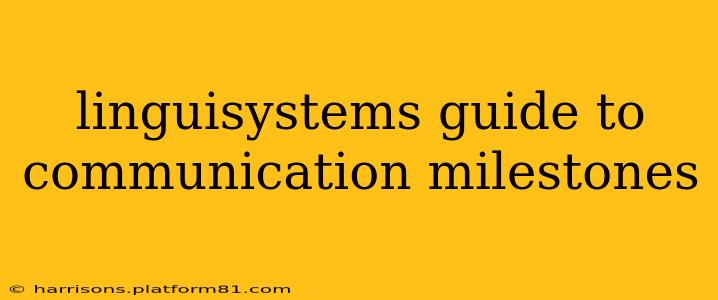Communication is the cornerstone of human interaction, and its development is a fascinating journey marked by significant milestones. This Linguisystems guide provides a comprehensive overview of these milestones, categorized by age, highlighting key achievements and offering insights into typical variations. Understanding these milestones helps parents, educators, and caregivers identify potential developmental delays and support children's communication growth effectively.
What are Communication Milestones?
Communication milestones represent the typical stages a child progresses through in developing their ability to understand and express themselves. These milestones encompass various aspects of communication, including:
- Receptive language: Understanding what others say.
- Expressive language: Expressing oneself verbally and non-verbally.
- Social communication: Using language appropriately in social contexts.
It's crucial to remember that these are guidelines, not rigid rules. Children develop at different paces, and variations within the normal range are perfectly acceptable. However, consistent delays or significant deviations warrant professional consultation.
Communication Milestones: From Birth to Five Years
This section breaks down key communication milestones across various age groups, offering a clearer understanding of typical development.
0-6 Months: The Foundation of Communication
Receptive Language: Infants begin responding to sounds and voices. They'll turn their heads towards sounds, show preference for human voices, and begin to recognize familiar faces.
Expressive Language: Nonverbal communication dominates this stage. Babies use crying, gurgling, cooing, and other vocalizations to express their needs and emotions. They also begin to develop early social smiles and eye contact.
6-12 Months: First Words Emerge
Receptive Language: Babies understand simple words like "no" and their name. They respond to simple instructions, such as "wave bye-bye."
Expressive Language: Around 9-12 months, babies typically begin babbling and may say their first few words, often mama or dada. They start to point at objects and people to indicate their interest.
12-18 Months: Expanding Vocabulary
Receptive Language: Understands simple instructions and questions ("Where's your toy?"). Follows simple directions involving two actions ("Get your shoes and put them on").
Expressive Language: Vocabulary expands to 6-20 words. Begins using single words to communicate needs and wants.
18-24 Months: Putting Words Together
Receptive Language: Understands more complex instructions and questions. Follows multi-step directions.
Expressive Language: Starts combining words into simple phrases (e.g., "Mommy go"). Vocabulary grows rapidly to 50-200 words. Uses gestures and nonverbal cues along with words to communicate.
2-3 Years: Sentence Construction
Receptive Language: Understands simple stories and follows directions more accurately. Can answer simple questions like "What's your name?"
Expressive Language: Speaks in simple sentences (e.g., "I want juice"). Uses pronouns correctly ("I," "me," "you"). Vocabulary continues to grow significantly. May begin to engage in pretend play, further developing their language skills.
3-5 Years: Complex Communication
Receptive Language: Understands longer sentences and complex instructions. Can follow multi-step directions with ease.
Expressive Language: Speaks in more complex sentences. Asks and answers more sophisticated questions. Can retell simple stories. Vocabulary continues to expand dramatically. Engages in conversations and participates more fully in social interactions.
What if my child isn't meeting these milestones?
If you have any concerns about your child's communication development, it's essential to consult with your pediatrician or a speech-language pathologist. Early intervention is key to addressing any potential delays and ensuring your child reaches their full communicative potential.
How can I support my child's communication development?
Providing a rich and stimulating environment is crucial. This includes:
- Talking to your child frequently: Engage in conversations, read books together, and sing songs.
- Responding to your child's attempts to communicate: Acknowledge their babbling, gestures, and words.
- Using clear and simple language: Avoid baby talk for extended periods, ensuring your child is exposed to appropriate vocabulary.
- Reading books together: Reading aloud exposes children to new words and sentence structures.
- Playing interactive games: Games that involve communication and language development can be very beneficial.
This Linguisystems guide offers a general overview. Remember that individual variations are expected, and seeking professional advice is vital if you have any concerns about your child's progress. Early identification and intervention are crucial for successful communication development.
